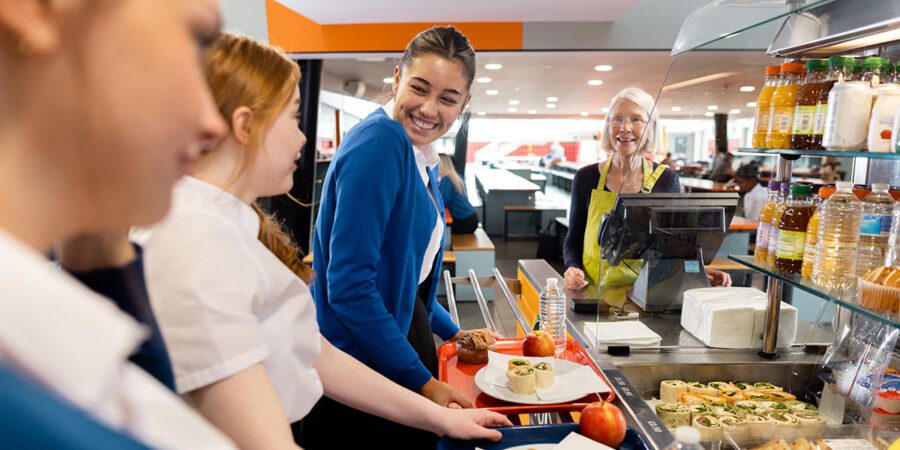
University
The State of Student Food Insecurity in 2025 (and How You Can Help)
Written by: Parcel Pending
5 Min Read
Published: March 27, 2025
Between rising tuition costs, growing inflation, insufficient minimum wages, reduced federal funding, and skyrocketing housing expenses, it’s no wonder that a substantial number of college students are currently struggling with food insecurity. With so many students facing uncertainty about where their next meal comes from, there is a critical need among higher education institutions to create immediate support systems for students in need. This blog examines the situation in greater detail and offers guidance on how you can help the campus community at your college or university.
The Scope of Food Insecurity
Food insecurity is a pressing problem, with 38% of students at four-year institutions experiencing it, and rates climbing even higher at community colleges (48%) and two-year schools (44%).1 A 2024 Hope Center survey reveals that 41% of students faced food insecurity within just the past month, with fewer than half (44%) reporting consistent access to adequate food.2 More alarming, the survey shows that 59% experienced at least one form of basic needs insecurity related to food or housing in the past year.
Unfortunately, students don’t appear to be aware of or utilizing available support funding, resources, or services. The survey reports half of them didn’t receive federal funds, and nearly half (48%) didn’t tap into college resources. Further, it shows two in three students reported they didn’t know about on-campus services and supports, and 26% had concerns about resource scarcity, leading them to use fewer on-campus resources than they would have otherwise.
The students most affected by food insecurity are part-time students, Pell Grant recipients, students of color, students with disabilities, former foster youth, and those who have been incarcerated.
Food Insecurity’s Impact on the Student Population
Research reveals the severe consequences of food insecurity for college students, who are going hungry at a higher rate than the U.S. population as a whole.3 According to Trellis Strategies’s Research Manager Allyson Cornett, students from food-insecure households are 43% less likely to complete their degrees.4 The effects also extend beyond academics, as these students also experience reduced sleep quality, poorer nutrition, and heightened anxiety levels.
As Jaime Hansen, Executive Director of Swipe Out Hunger, explains: “This severe lack of sustainable funding for antihunger programs is preventing students from accessing the food they need to survive, which in turn affects their ability to stay enrolled. With rising food costs and the lack of government support, campus food pantries and similar resources are becoming the only lifeline for students. If these programs continue to be overburdened and underfunded, we can expect to see less students being able to afford to stay in college.”5
Current Challenges Around Healthy Food Access
A 2024 Swipe Out Hunger survey revealed that college students currently face multiple barriers to accessing healthy food options:6
- Time constraints from juggling academic responsibilities, work, and extracurricular activities limits their ability to shop for and prepare nutritious meals
- The high cost of campus meal plans and on-campus dining creates financial strain
- Individuals with specific dietary needs often face even higher costs for specialized foods
- Many students live in areas far from affordable grocery stores, creating transportation challenges that further restrict their access to nutritious food options
Better understanding which challenges your students face can help you tailor support services to best help your campus community.
Food Pantries Remain the Preferred Solution
Food pantries are the most popular campus support program, with 95% of schools offering one.7 In 2024, Swipe Out Hunger says campus pantries distributed over 8 million meals and 687,000 additional items, including toiletries, diapers, and appliance lending.8
Campus leaders are increasingly adapting these programs or seeing increased adoption if they are already in place. For instance, the University of Oklahoma’s pantry participation more than doubled in recent years – jumping from 180 to over 450 students and staff served.9 Matt Marks, director of the Sooner program, highlights a key challenge: “There are times where you can feel there’s a stigma or a shame that may prevent [those in need] from asking for help.”
Creating More Food Pantry Access with Smart Lockers
Smart lockers are a transformative solution for expanding campus food pantry access, allowing institutions to provide resources around the clock without requiring additional staff or dedicated space. This self-service model also eliminates the stigma often associated with seeking food assistance, as students can discreetly retrieve items at times that fit their schedules.
By strategically installing lockers across campus, institutions can make nutritious food readily available between classes, during study sessions, or during library visits, which is particularly valuable for students who live in areas with limited access to affordable grocery options.
For example, SUNY Polytechnic Institute in Marcy recently unveiled its new Poly Pantry Food Lockers, cutting the ribbon on an innovative system that provides students with 24/7 access to food resources.10 Part of a broader SUNY pilot program aimed at addressing food insecurity on college campuses, the system enables students to scan their codes at a centralized kiosk to access food items, with lockers programmed to permit student access for up to 72 hours.
Bunker Hill Community College (BHCC) has also emerged as a leader in tackling food insecurity by integrating parcel lockers into its DISH Food Pantry. This innovative approach reduces stigma, streamlines distribution, and offers a more convenient, self-service model for students in need. Reflecting on BHCC’s commitment, Molly Hansen, former Senior Special Programs Coordinator for DISH, stated, “Our administration and student government recognized that more than half of our student population struggled with food insecurity.”
In 2023 alone, the DISH Food Pantry achieved remarkable results:11
- Distributed 69,647 pounds of food
- Filled 2,687 grocery orders
- Processed 899 new intake forms encompassing 851 students and 48 faculty/staff
- Fulfilled 19,900 total Grab & Go visits
Unfortunately, the problem of food insecurity is unlikely to disappear anytime soon for college students. Smart lockers enable colleges to implement a food pantry delivery system that circumvents the stigma, provides 24/7/365 access, and allows for convenient food retrieval.
Ready to integrate smart lockers at your college to help with food insecurity? Speak to a Parcel Pending representative today!
Sources:
- Landry, Matthew J. & Eicher-Miller, Heather. Pandemic threatens food security for many college students. theconversation.com. October 9, 2020. https://theconversation.com/pandemic-threatens-food-security-for-many-college-students-146823
- Mowreader, Ashley. Survey: 3 in 5 College Students Experience Food or Housing Insecurity. www.insidehighered.com. February 27, 2025. https://www.insidehighered.com/news/student-success/health-wellness/2025/02/27/most-college-students-lack-sufficient-food-housing
- Savage, Jess. More college students are struggling to get enough food. What colleges are doing about it. www.kcur.org. September 30, 2024. https://www.kcur.org/news/2024-09-30/college-students-food-insecurity
- Ibid.
- Mowreader, Ashley. Infographic: Food Support Programs Reach 700,000 College Students. www.insidehighered.com. February 18, 2025. https://www.insidehighered.com/news/student-success/health-wellness/2025/02/18/39-colleges-rely-donors-address-food-insecurity
- Ibid.
- Ibid.
- Ibid.
- Sequeira, Robbie. Campus food pantries are seeing greater demand – and more state dollars. stateline.org. August 30, 2023. https://stateline.org/2023/08/30/campus-food-pantries-are-seeing-greater-demand-and-more-state-dollars/
- Neff Roth, Amy. Some college students don’t get enough to eat: SUNY Poly has new way to help them. www.uticaod.com. March 11, 2025. https://www.uticaod.com/story/news/2025/03/11/food-insecurity-issue-for-college-students-food-pantries-help-suny/82239205007/
- Bunker Hill Community College DISH Food Pantry. 2023 DISH Annual Report. www.bhcc.edu. n.d. https://www.bhcc.edu/media/03-documents/dishfoodpantry/Dish-Annual-Report.pdf



